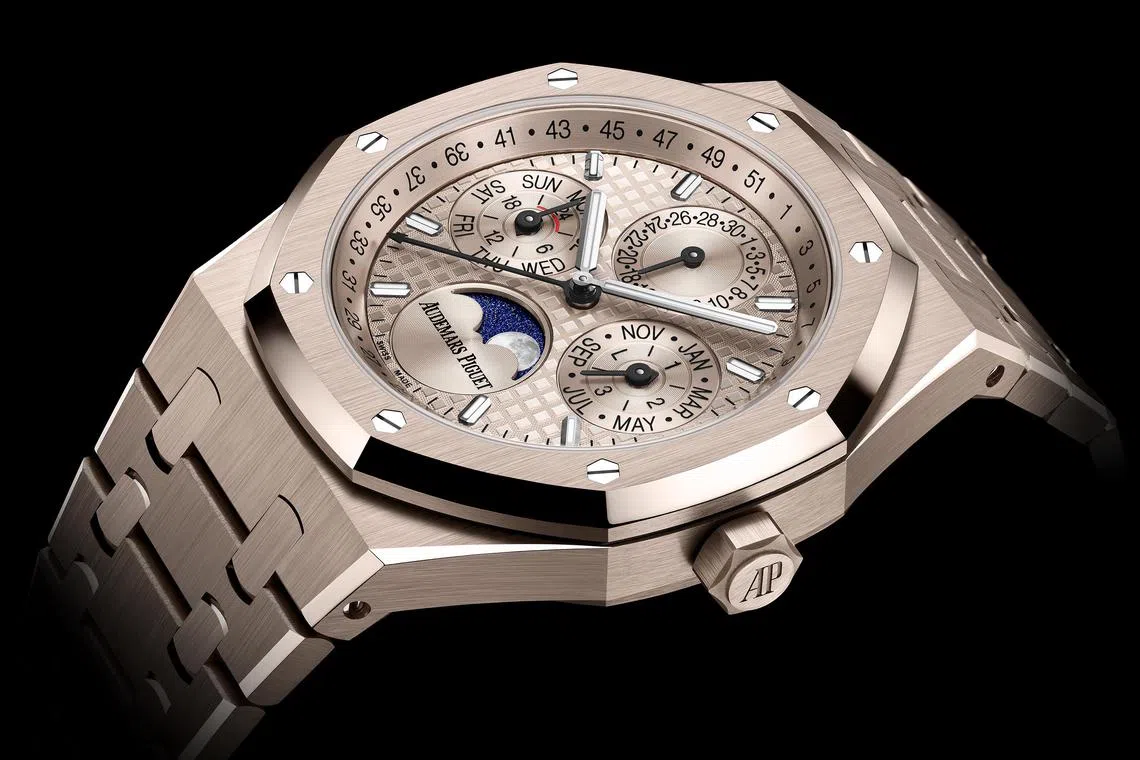Audemars Piguet launches 150th anniversary celebrations with ‘all-in-one’ perpetual calendar movement
Sign up now: Get ST's newsletters delivered to your inbox

The Calibre 7138 blends user-friendly design with Audemars Piguet’s rich history of astronomical watchmaking.
PHOTO: AUDEMARS PIGUET
Follow topic:
GENEVA – In February 2025, a troupe of international watch journalists gathered at The Arc, Audemars Piguet’s (AP) sleek new manufacturing facility in the picturesque village of Le Brassus, nestled in Switzerland’s Vallee de Joux.
The setting was perfect for a theatrical launch of the Swiss brand’s 150th anniversary celebrations. A lively pantomime unfolded, complete with stunning stage props that mirrored the celestial beauty of the skies above Le Brassus and a dynamic cast of dancers and performers.
At the helm were chief executive Ilaria Resta and heritage and museum director Sebastian Vivas, who wove a captivating tale of AP’s journey and how it navigated wars, economic storms and the quartz crisis to become a horological powerhouse with annual earnings of over US$2.5 billion (S$3.36 billion).
The celestial backdrop was chosen to highlight the star of the celebration – the revolutionary Calibre 7138 self-winding perpetual calendar movement. This game changer features an “all-in-one” crown that simplifies adjustments, eliminating the need for fiddly correctors and specialised tools.
A horological marvel which debuted in the 18th century, the perpetual calendar is an intricate astronomical complication which boasts a mechanical memory that can track 48-month cycles. It automatically adjusts the varying number of days in each month, including leap years, making it incredibly accurate.
Remarkably, the mechanism requires manual adjustment only once every 100 years to stay in sync with the solar calendar.
More than just a new movement, the Calibre 7138 is a reimagined classic complication that blends user-friendly design with AP’s rich history of astronomical watchmaking.
It makes its debut in a 41mm Code 11.59 model in white gold, as well as two 41mm Royal Oak models in steel and sand gold. Additionally, there are three limited-edition anniversary versions, each with unique aesthetic touches that pay tribute to the brand’s 150-year legacy of craftsmanship.
To understand the significance of the Calibre 7138, it is essential to look back at key moments in the history of AP, founded in 1875 by good friends Jules Louis Audemars and Edward Auguste Piguet.
The brand’s early astronomical inclinations led the pair to craft several remarkable pieces, including one by Audemars that integrated a perpetual calendar with a quarter repeater and a deadbeat seconds complication. Despite these early achievements, calendar complications accounted for less than 10 per cent of the brand’s total production in its first two decades.
It was only in 1921 that AP produced its first complete calendar wristwatch which was sold three years later to Gubelin, a renowned retailer. By 1955, AP had cemented its reputation by releasing the world’s first perpetual calendar wristwatch with leap year indication.
In 1978, when the traditional watch world was reeling from the onslaught of quartz movements, AP defied trends and detractors to launch the thinnest self-winding perpetual calendar wristwatch of its time, the Calibre 2120/2800.
In 1984, the ground-breaking movement was integrated into the iconic Royal Oak – which debuted in 1972 – cementing the model’s status as a horological icon. This was soon followed by other references in the collection.
Other milestones? The Royal Oak Selfwinding Perpetual Calendar Ultra-Thin RD#2 in 2018. Housing the Calibre 5133 (2.89mm in height), it was the world’s thinnest automatic perpetual calendar wristwatch of its time at just 6.3mm in thickness.
That brings us to today and the Calibre 7138, which took five years of research and development and is protected by five patents.

The Calibre 7138 has a revolutionary “all-in-one” crown that allows the wearer to adjust all functions of the perpetual calendar without the need for any tools.
PHOTO: AUDEMARS PIGUET
Traditional perpetual calendar wristwatches typically feature correctors embedded in the side of the case, requiring a tool to adjust the various subdials. This system can be cumbersome, especially if the watch has been left unwound for an extended period. To get around this, AP engineers set out to create a more intuitive and user-friendly solution.
The new “all-in-one” crown incorporates four distinct positions. The first position winds the watch clockwise, the second position sets the date clockwise and adjusts the month and leap year in the opposite direction, the third position sets the time bi-directionally while the final position (position 2’) sets the day and week clockwise and the moon phases counterclockwise.
This simplified system is driven by an innovative lever and wandering wheels mechanism that meshes with the different calendar wheels in positions 2 and 2’. AP has secured two patents for this innovation: one for the crown correction system with a 2’ position and another for the month and date correction via the crown.
Mr Lucas Raggi, AP’s research and development director, says: “Calibre 7138 represents a major innovation in the design of perpetual calendars. By placing ergonomics at the heart of our research and development, we have created a unique correction mechanism that allows all adjustments to be made via the crown.
“In addition to making this high complication easy to use, we also worked on the overall aesthetics to combine high legibility with timeless refinement,” he adds.
The dial now features a European date display, with the day at 9 o’clock, the date at 12 and the month at 3 o’clock. A 24-hour indicator has been inserted in the day subdial at 9 o’clock. The moon-phase display, depicting an image of the moon based on a Nasa photograph, remains at 6 o’clock. However, the full moon is now centred on the 12 o’clock axis to enhance the dial’s overall balance.
Calibre 7138 beats at a frequency of 4Hz (28,800 vph) and offers a power reserve of minimum 55 hours.
The first three pieces housing the movement are head-turners. Priced at 88,000 Swiss francs (about S$131,500), the Code 11.59 model flaunts a vibrant blue embossed dial accentuated by 18-karat white gold hands and hour markers infused with luminescent material.
It features a pattern of concentric circles in smoked blue PVD shades, created in collaboration with Swiss guilloche artisan Yann von Kaenel. The watch is fitted with a blue rubber-coated strap with calfskin lining to match the dial’s hue.

The Code 11.59 model flaunts a vibrant blue embossed dial accentuated by 18-karat white gold hands and hour markers infused with luminescent material.
PHOTO: AUDEMARS PIGUET
Meanwhile, the first Royal Oak model (88,000 Swiss francs) – featuring a two-tone design – combines a stainless-steel case and bracelet with a blue PVD Grande Tapisserie dial, also enhanced by 18-karat white gold hands and hour markers, all filled with luminescent material.
The second Royal Oak model (130,000 Swiss francs) is crafted in 18-karat sand gold – a unique alloy of gold, copper and palladium introduced in 2024. Shimmering between white and pink gold, it changes colour in different light conditions.

One of the Royal Oak models is crafted in 18-karat sand gold – a unique alloy of gold, copper and palladium introduced in 2024.
PHOTO: AUDEMARS PIGUET
All three models are limited to 150 pieces and feature a sapphire caseback, revealing the intricate beauty of the Calibre 7138 movement.


